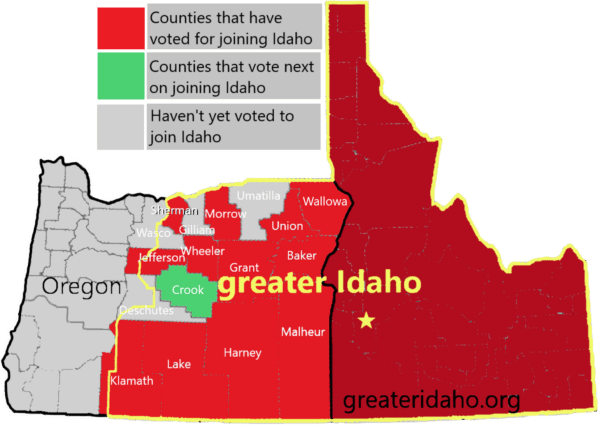Greater Idaho Wins 12th County in a Row in Eastern Oregon
Greater Idaho, May 17, 2023
The Greater Idaho movement has now won elections in every county of eastern Oregon that has voted on the idea, for a total of twelve counties, according to election night results, and the movement’s proposal only includes fourteen full counties of eastern Oregon. Since the introduction of a law that allows ballots to be received after election day if they were mailed on or before election day, the final election results in favor of Greater Idaho ballot measures have always been one to four percentage points higher than the election night results, so the Greater Idaho movement feels confident that their measure has won the Wallowa County election, even though results at 2pm PT today today only showed their measure ahead with 50.3% of the vote. Since the movement’s first election 6 election cycles ago, it had averaged 62% in favor and 38% opposed, a ratio of 1.63 to 1.
UPDATE: the Wallowa County Clerk… “said she has no idea how many of either the challenged or the late-mailed ballots to expect. In November 2022, she estimated receiving about 28 late ballots.” Therefore it is very unlikely that the measure will fail to pass.
Wallowa County Chieftain, May 18, 2023
The Wallowa County turnout as of 2pm PT today was 55%, more than double the statewide average. The five counties that voted on a Greater Idaho ballot initiative in the last off-year election, two years ago, also turned out at almost twice the statewide average.
Wallowa County only has two percent of the population of eastern Oregon, and its beautiful mountain views draw an unusually large percentage of upper-income residents from the Willamette Valley, who may have been less supportive of joining Idaho.
Another reason Wallowa County may have been less sure than other counties about the movement, according to a statement at the movement’s website, greateridaho.org, is that Portland Democrats outspent them in Wallowa County to level false accusations. Their ads claimed that far-right individuals and groups support the movement, but had no evidence that the movement supports those individuals or groups. The ads implied that those far-right groups are the people behind the movement, but Greater Idaho leadership says they’ve never been contacted by those individuals or groups. Their other ads claimed that joining Idaho would be financially bad for eastern Oregon and that the group hasn’t done an economic analysis. But independent economists proved that Idaho’s governance would be good for eastern Oregon.
Portlanders such as Former Dem. state rep. Ben Unger and social justice warrior group Western States Strategies sent four or five mailers and advertised on YouTube and Pluto TV during the campaign. Despite decades of experience in Oregon politics, they chose to send ads without revealing who was sending them, and didn’t register or report to the state their campaign expenditures or income as required by transparency law. After they were confronted with their apparent violations of campaign finance law, they chose to order more ads for the following two weeks. The movement filed a complaint with the state on May 5 and will file another this week.
The movement believes that state leaders should want to let eastern Oregon join Idaho because it would benefit Oregon’s state budget, and because eastern Oregon’s state senators appear to have decided to block votes in the Oregon Senate indefinitely unless state leadership changes course. The group tweeted “Rural Oregon will keep electing more kamikazee Republicans who are willing to bring the Oregon Legislature to a halt every year if that’s what it takes to block unacceptable laws from being passed. If you don’t like that, then let us join Idaho, and w. OR can have a bluer blue state… Our state senators can trade places with state reps every 4 years and keep the Oregon Senate floor votes shut down forever. Contact Speaker Dan Rayfield to ask him to let our movement have an informational hearing to explain the sources of, and solutions to, the discontent in rural Oregon.”

{snip}















